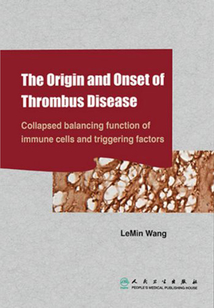首頁 > 醫學 > 其他 > The Origin and Onset of Thrombus Disease: collapsed balancing function of immune cells and triggering factors 血栓病的起源與發生:免疫細胞平衡功能崩潰與啟動機制
舉報 

會員
The Origin and Onset of Thrombus Disease: collapsed balancing function of immune cells and triggering factors 血栓病的起源與發生:免疫細胞平衡功能崩潰與啟動機制
本書為英文版,分為10章,以公開發表的學術論文為依據,按照靜脈血栓和動脈血栓的線條,闡述血栓發生的多個環節,重點闡述免疫紊亂至崩潰在血栓起源中的意義。主要內容包括靜脈血栓形成機制的新認識及臨床質疑、急性靜脈血栓形態學、核心蛋白的細胞學監測、靜脈血栓與病原微生物、VTE與免疫細胞功能降低、免疫系統的功能與調節、基因組學、動物實驗。
最新章節
- Chapter 15 Epilogue: To make it simple
- 3.Similarities and differences of internal and external factors between acute venous and arterial thrombosis
- 2.Gist of acute arterial thrombosis
- 1.Gist of acute venous thrombosis
- Chapter 14 Differences of origin and onset between acute venous and arterial thrombus
- Part III Summary and prospect
品牌:人衛社
上架時間:2020-02-21 13:04:09
出版社:人民衛生出版社
本書數字版權由人衛社提供,并由其授權上海閱文信息技術有限公司制作發行
- Chapter 15 Epilogue: To make it simple 更新時間:2020-02-21 13:28:46
- 3.Similarities and differences of internal and external factors between acute venous and arterial thrombosis
- 2.Gist of acute arterial thrombosis
- 1.Gist of acute venous thrombosis
- Chapter 14 Differences of origin and onset between acute venous and arterial thrombus
- Part III Summary and prospect
- Chapter 13 The impaired innate and adaptive immunity in patients with coronary artery diseases
- 7.Comparison of gene expression of Integrin β2 between AMI and SAP patients
- 6.Expression characteristics of B cell related genes in patients with AMI and SAP
- 5.Expression characteristics of T cell related genes in AMI and SAP patients
- 4.Expression characteristics of cytokine related genes in patients with AMI and SAP
- 3.Expression characteristics of complement system related genes in patients with AMI and SAP
- 2.Expression characteristics of natural killer cell related genes mRNA in patients with AMI and SAP
- 1.Expression characteristics of neutrophil and mononuclearphagocyte related genes in patients with AMI and SAP
- Chapter 12 Human genomics in patients with acute myocardial infarction
- References
- Results
- Data analysis
- RT-PCR
- Chip scan and Data acquisition
- Microarray hybridization
- RNA amplification and labeling
- Total RNA isolation
- Gene expression chips
- Patient information
- Acute arterial thrombosis and differentially expressed genes—Significantly reduced function of T cells
- Chapter 11 Human genomics in patients with acute myocardial infarction—pandect
- References
- Chapter 10 New viewpoints on the pathogenesis of acute arterial thrombosis
- Part II Arterial thrombus
- 4.Acute VTE and high expression of CH50
- 3.Symptomatic VTE is a disease related to infection and immune dysfunction
- 2.T cell-mediated immune deficiency in patients with CTEPH
- 1.The patients with acute PE and Dysfunction of CD3CD8 T cells
- Chapter 9 VTE and immune cell dysfunction
- References
- Mutations of 2 genes predicted to be functionally damaged
- Exome Sequencing
- Detection of complement components
- Examination of differentiation antigens on immune cells
- Examining PRF1 HTR2A and ABCC8 mutations in control individuals
- Sequence mapping and single nucleotide variation identification
- Exon capture and next-generation sequencing
- Clinical data of this Chinese family
- Chapter 8 Characterization of immune cell perforin mutations in a family with VTE
- 2.Systematics of genomics
- 1.Pandect—Network analysis of human genome differences
- Chapter 7 General theory of genomics in patients with symptomatic pulmonary thromboembolism (PE)
- References
- 2.Factors affecting immune cell functions
- 1.Immune function
- Chapter 6 Function and regulation of the immune system
- 3.Bacteremia and the occurrence of VTE in multiple organs
- 2.Virus-like structure in a patient with pulmonary hypertension and VTE
- 1.Severe Acute Respiratory Syndrome and VTE in multiple organs
- Chapter 5 Venous thrombus and pathogenic microorganism
- 4.Expression of the same or different proteins in venous thromboembolism and different risk factor group patients
- 3.Increased expressions of integrin subunits β1 β2 and β3 in patients with cancer
- 2.Increased expressions of integrin subunits β1 β2 and β3 in patients with acute infection
- 1.A New marker for diagnosis of VTE
- Chapter 4 Cytological detection of core proteins
- 6.Venous Thrombosis is a product in proliferation of cancer cells
- 5.Nest-like biological venous filter within acute venous red thrombus
- 4.The inflammatory immune adherence is involved in the whole process of acute venous thrombosis
- 3.Core proteins in acute venous thrombus
- 2.Main protein components of acute venous thrombus
- 1.Pathology of acute venous thrombus
- Chapter 3 Components of acute venous red thrombus
- References
- 10.Core proteins may serve as new specific protein markers for VTE diagnosis
- 9.Expression of same / different proteins in venous thromboembolism and different risk factor group patients
- 8.Malignancy and VTE
- 7.Immune cell function with VTE
- 6.DNA sequence mutation in familial VTE patients
- 5.Significant downregulation of human immune system related gene mRNA expressions
- 4.Inevitability of building a new intravenous defense line
- 3.Localization of core proteins in acute venous thrombus
- 2.Protein components analysis of acute venous thrombus
- 1.Questions from clinics
- Chapter 2 The answer to the onset of acute venous thrombus
- Chapter 1 The origin and onset of acute venous thrombus
- Part I Venous thrombus
- Introduction
- Acknowledgment
- Preface
- About the Author
- 版權頁
- 封面
- 封面
- 版權頁
- About the Author
- Preface
- Acknowledgment
- Introduction
- Part I Venous thrombus
- Chapter 1 The origin and onset of acute venous thrombus
- Chapter 2 The answer to the onset of acute venous thrombus
- 1.Questions from clinics
- 2.Protein components analysis of acute venous thrombus
- 3.Localization of core proteins in acute venous thrombus
- 4.Inevitability of building a new intravenous defense line
- 5.Significant downregulation of human immune system related gene mRNA expressions
- 6.DNA sequence mutation in familial VTE patients
- 7.Immune cell function with VTE
- 8.Malignancy and VTE
- 9.Expression of same / different proteins in venous thromboembolism and different risk factor group patients
- 10.Core proteins may serve as new specific protein markers for VTE diagnosis
- References
- Chapter 3 Components of acute venous red thrombus
- 1.Pathology of acute venous thrombus
- 2.Main protein components of acute venous thrombus
- 3.Core proteins in acute venous thrombus
- 4.The inflammatory immune adherence is involved in the whole process of acute venous thrombosis
- 5.Nest-like biological venous filter within acute venous red thrombus
- 6.Venous Thrombosis is a product in proliferation of cancer cells
- Chapter 4 Cytological detection of core proteins
- 1.A New marker for diagnosis of VTE
- 2.Increased expressions of integrin subunits β1 β2 and β3 in patients with acute infection
- 3.Increased expressions of integrin subunits β1 β2 and β3 in patients with cancer
- 4.Expression of the same or different proteins in venous thromboembolism and different risk factor group patients
- Chapter 5 Venous thrombus and pathogenic microorganism
- 1.Severe Acute Respiratory Syndrome and VTE in multiple organs
- 2.Virus-like structure in a patient with pulmonary hypertension and VTE
- 3.Bacteremia and the occurrence of VTE in multiple organs
- Chapter 6 Function and regulation of the immune system
- 1.Immune function
- 2.Factors affecting immune cell functions
- References
- Chapter 7 General theory of genomics in patients with symptomatic pulmonary thromboembolism (PE)
- 1.Pandect—Network analysis of human genome differences
- 2.Systematics of genomics
- Chapter 8 Characterization of immune cell perforin mutations in a family with VTE
- Clinical data of this Chinese family
- Exon capture and next-generation sequencing
- Sequence mapping and single nucleotide variation identification
- Examining PRF1 HTR2A and ABCC8 mutations in control individuals
- Examination of differentiation antigens on immune cells
- Detection of complement components
- Exome Sequencing
- Mutations of 2 genes predicted to be functionally damaged
- References
- Chapter 9 VTE and immune cell dysfunction
- 1.The patients with acute PE and Dysfunction of CD3CD8 T cells
- 2.T cell-mediated immune deficiency in patients with CTEPH
- 3.Symptomatic VTE is a disease related to infection and immune dysfunction
- 4.Acute VTE and high expression of CH50
- Part II Arterial thrombus
- Chapter 10 New viewpoints on the pathogenesis of acute arterial thrombosis
- References
- Chapter 11 Human genomics in patients with acute myocardial infarction—pandect
- Acute arterial thrombosis and differentially expressed genes—Significantly reduced function of T cells
- Patient information
- Gene expression chips
- Total RNA isolation
- RNA amplification and labeling
- Microarray hybridization
- Chip scan and Data acquisition
- RT-PCR
- Data analysis
- Results
- References
- Chapter 12 Human genomics in patients with acute myocardial infarction
- 1.Expression characteristics of neutrophil and mononuclearphagocyte related genes in patients with AMI and SAP
- 2.Expression characteristics of natural killer cell related genes mRNA in patients with AMI and SAP
- 3.Expression characteristics of complement system related genes in patients with AMI and SAP
- 4.Expression characteristics of cytokine related genes in patients with AMI and SAP
- 5.Expression characteristics of T cell related genes in AMI and SAP patients
- 6.Expression characteristics of B cell related genes in patients with AMI and SAP
- 7.Comparison of gene expression of Integrin β2 between AMI and SAP patients
- Chapter 13 The impaired innate and adaptive immunity in patients with coronary artery diseases
- Part III Summary and prospect
- Chapter 14 Differences of origin and onset between acute venous and arterial thrombus
- 1.Gist of acute venous thrombosis
- 2.Gist of acute arterial thrombosis
- 3.Similarities and differences of internal and external factors between acute venous and arterial thrombosis
- Chapter 15 Epilogue: To make it simple 更新時間:2020-02-21 13:28:46


